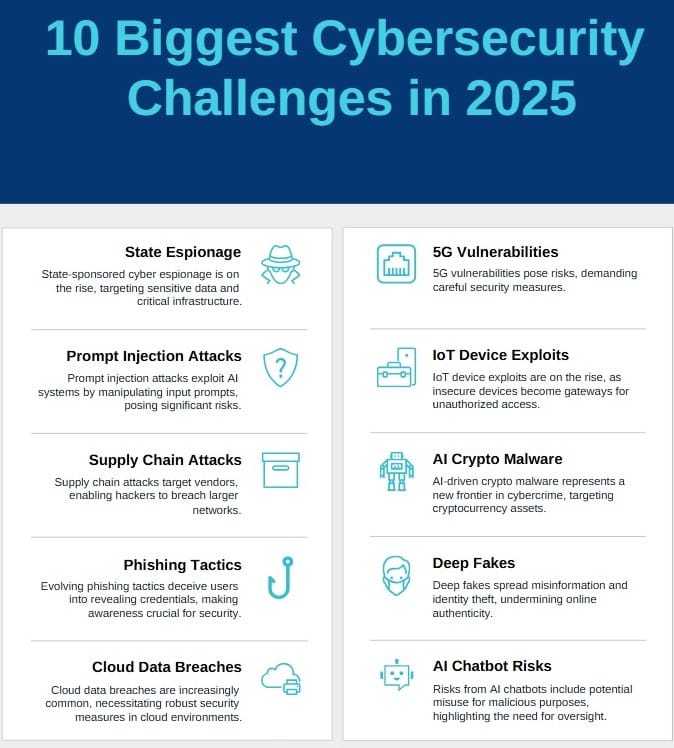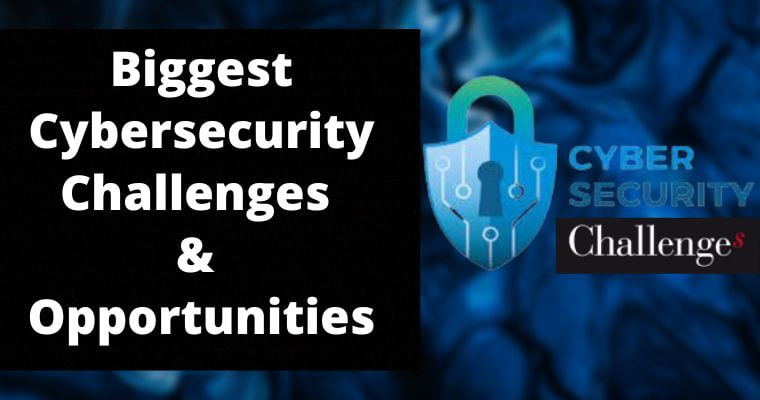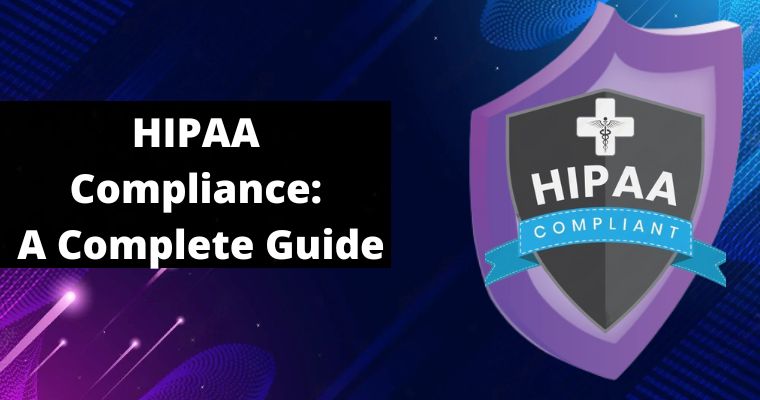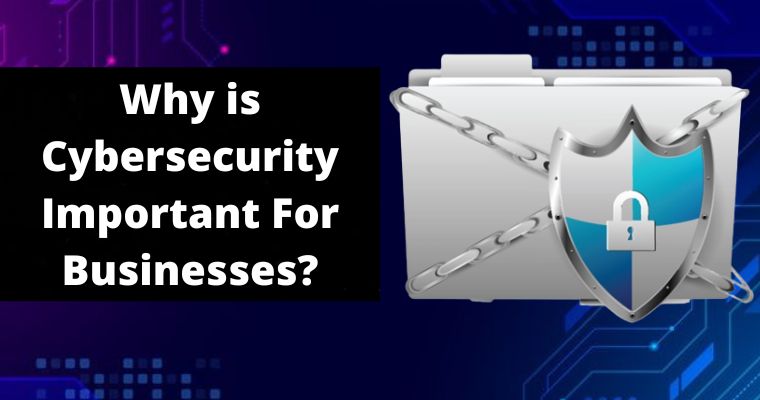In this article, we will discuss major cybersecurity challenges that may arise in 2025.
Cybersecurity is practices and methods used to protect servers, networks, devices, and cloud storage from malicious attacks.
Cybercriminals exploit the vulnerabilities in a system and use them in their favor which can be a cyber-attack or cyberterrorism.
Moreover, it can be estimated that the coming years will be difficult and will demand pioneer methods of defending against these cyber-attacks.
Table of Contents
What are the Challenges of Cybersecurity?
With the rapid growth in technology and its influence in all sectors, the risk related to the Internet world has also increased immensely.
Cybercrimes have taken new advanced methods to affect the population in the contemporary world.
cyber threats have extended their reach to malware attacks, data stealing, decryption of codes, hacking payment gateways, etc.
Due to the drastic development in technologies, consistent growth is also required for cyber safety. The world has already seen various forms of cyberattacks.
Still, there are many potential fields where Cybercrime has been initiated, and it has become a major cybersecurity challenge for developers and cybercrime experts to be prepared.
10 Biggest Cybersecurity Challenges in 2025

The major cybersecurity challenges that can potentially threaten the world in 2025 are:
1. Espionage
The method of spying using the Internet is not very new. Cybercriminals have used different ways of Espionage to access valuable information.
One such example is the Pegasus affair. This method is complex and difficult to predict because of the wide range of possibilities that can be used.
Malware applications demand permission from your phone or computer to access your camera and microphone, and the access can be used to steal information and various activities of that system.
Apart from personal level secrecy, big companies have to worry about keeping their trade secrets safe from such attacks.
New defensive methods of securing systems and collaboration between private and public sectors will be critical to increasing security concerns and obtaining immunity from this kind of Cybercrime.
2. Prompt Injection Attacks
Prompt Injection is a type of attack where a malicious actor manipulates the input (prompt) to an LLM in a way that causes it to behave unexpectedly, leak data, or execute unauthorized actions.
Two types of Prompt Inject attacks, that is direct and indirect.
Direct Prompt Injection: The attacker explicitly inserts commands into a prompt.
Indirect Prompt Injection: Malicious prompts are embedded in third-party content (e.g. websites, documents, emails) that the LLM consumes later.
These involve manipulating AI models through crafted inputs to produce unintended or malicious outputs. As AI becomes more embedded in business processes, securing these systems against such attacks is paramount.
3. Supply Chain Attack
In this, cyber-attackers seek to damage an organization by focusing on the supply chain’s vulnerable and less secure elements.
This kind of attack is possible in any industry or sector like financial, educational, government, etc. Cybercriminals install a rootkit or hardware-based-spying component of the manufacturing process.
Supply chain attacks can have multiple forms and have no set definition for threat analysis. The supply chain is a large network of affiliated organizations or people governed by supply and demand.
The greater challenge that will lie in government and private sectors regarding supply chain attacks will be to be more aware and responsive towards the security of chosen partners and validate that good security hygiene is in place.
Big industries and business sectors need to primarily take care of these attacks.
Cybercriminals also aim for e-commerce websites and divert the traffic or hack the server to take advantage of the small-time window allotted for the sale or any other purposes. These attacks can result in great financial losses and loss of credibility.
4. Phishing Tactics
In Phishing tactics, cyber criminls use false names of reputed sources for sending fraudulent communications—the major methods used in this attack email. Mainly, the purpose is to extract useful information under a fake reputation.
These emails can ask for your credit card information or login credentials. They are also used to export malware on the victim’s machine. Phishing is one of the oldest and most common forms of cyberattacks.
It can lead to financial loss or result in a hacked account. Cybercrime attacks like Advanced persistent threats (ATPs) and ransomware primarily start with phishing attacks.
User education is the primary method of protection against such forms of attacks. Users can also look up to security technologies and implement a layered approach to reduce the number of attacks.
The network security for email and web security shall be maintained and enhanced to avoid phishing attacks. These attacks are very simple and yet very lucrative.
5. Cloud Data Breaches
Cloud data breaches refer to unauthorized access, exposure, or theft of data stored in cloud environments. These incidents can have significant consequences, including data loss, regulatory fines, reputational damage, and operational disruption.
Cybersecurity challenges in cloud data breaches arise from the dynamic, distributed, and shared nature of cloud computing.
Organizations often don’t have full visibility into how data is stored, accessed, and moved in the cloud especially in multi-cloud or hybrid environments.
Cloud providers and customers share security responsibilities, but confusion over what each party is responsible for can leave gaps.
Cloud platforms have complex settings and default configurations that are often left unsecured. Open storage buckets, insecure security groups, and public APIs become easy targets for attackers.
Cloud services are accessed via APIs, which can be poorly secured or documented. Exploiting these APIs can give attackers unauthorized access to sensitive systems or data.
6. 5G Network Vulnerabilities
The transition to 5G networks brings enhanced speed, ultra-low latency, and massive connectivity, but it also introduces new cybersecurity challenges.
The encryption of the 5G network is still in the testing phase, and it can be a major challenge to avoid cybercrimes with the 5G technology.
Unlike centralized 4G networks, 5G uses a more distributed model, exposing more network points to potential attacks.
5G relies on a diverse range of vendors and software providers, which increases the risk of backdoors or malicious components being introduced during development or deployment.
5G uses NFV (Network Function Virtualization) and SDN to increase flexibility. These technologies can be compromised if the virtual infrastructure is not securely configured and monitored.
5G enables network slicing, where multiple virtual networks run on the same physical infrastructure.
Improper isolation between slices can lead to data leakage or attacks across slices. Multiple tests and Surveillance must be placed over the usage of 5G networking to ensure that the system is secure and highly encrypted.
With the enhanced speed and smooth response of smartphones, it is equally important to ensure the safeguarding of data and servers over the new network.
7. Internet of Things (IoT) Exploits
IoT has been developing in recent years and has reached a point where multiple devices and accessories are connected over a large network.
Home automation, security systems, surveillance systems, and many more technologies have integrated IoT as a major component.
Lights, vehicles, sensors, robots, phones, and TVs can all be connected under one wide network and can work together, creating a bigger network of potential threats.
The access of multiple devices can be hacked using the glitches in the IoT network. There are two types of vulnerabilities that are majorly into consideration.
First is hacking the hardware components through ports or using different data transporters to gain information about the connecting services and owner. The second is the security of the server.
Since all the devices work over a single server establishing a connection, it is vital to ensure that the server is protected using multiple security layers.
A breach in the server can lead to great amounts of diverse data loss. IoT services must be tested for all possible risks, and the users must be aware of the connection and permission of the data provided on the IoT platforms.
Lack of awareness can lead to major loss as cybercriminals can dive into the IoT platforms to extract personal details, access devices, and sensors, monitor and manipulate security services, etc.
8. AI Crypto Malware
AI-generated crypto malware refers to malicious software crafted or enhanced using artificial intelligence, enabling it to adapt, evade detection, and target cryptocurrency assets more effectively.
These malwares can autonomously evolve, making traditional security measures less effective.
AI-generated crypto malware has emerged as a significant cybersecurity threat in 2025, blending advanced artificial intelligence techniques with malicious intent to exploit vulnerabilities in the cryptocurrency ecosystem.
The evolving use of digital wallets and high-value cryptocurrencies makes them a tempting target for cybercriminals.
There are tests and investigations on the authenticity of these digital wallets and whether it is safe to store huge amounts of money in digital coins knowing that there are possible chances of cyber-attacks.
Mining should be done securely and only by using reliable and certified applications.
It is a time-consuming process and should be checked at all stages.
The credentials should not be stored over overcloud or other services accessible by cybercriminals because that will add a great danger of losing wealth and your cryptocurrency investment.
Cryptocurrency exchange applications must be verified for authentic sale and purchase. User profiles should be precisely monitored to restrict suspicious activities or manipulate the market with fraudulent currencies.
9. Deep Fakes
The power of information is very useful in manipulating crowds and behavior, changing decisions, and causing chaos.
There are many fake videos, misguiding speeches, and edited photos that are used to influence the public about false facts and beliefs.
The rise in Artificial Intelligence is proving to be a blessing in monitoring such fake programs and agendas. These fake presentations and manipulated information are also major weapons are cause cyber terrorism.
Complexities regarding Deep Fakes arise from several directions. Handling the attack surface will be a major task for authorities on digital grounds. The major requirements for taking such attacks will be:
- Providing real-time transparency.
- Monitor the major and common entry points.
- Monitoring attack vectors for prediction of such attacks and reduction in such activities.
- Identify the vulnerability of the system through active threat intelligence.
- Develop more advanced methods and algorithms into the primary security tools.
With the growing scope of causing defects in the system, the points mentioned earlier must be monitored stringently to avoid any such cyber-attack.
The user’s awareness of the basics of any new technology is essential to prevent any cyber threat lurking over.
Awareness programs and campaigns regarding multiple hazards are run to educate the users about the fraudulent practices currently under use.
Growth in Cybercrime requires the development of defense mechanisms and security protocols to ensure technology’s healthy and positive use.
The Internet world can never be peaceful and less chaotic unless some proper methods and programs restrict and eliminate cybercriminals.
Many companies have taken responsibility for minimizing the threat caused by these cyber criminals.
Different areas of cybersecurity have been keenly worked upon by various departments so that the security mechanisms can cover the horizon of potential risks.
Understanding the risk factors before indulging in online activities is important for a safer and happier experience.
10. AI Chatbot Risks
Researchers found that cybercriminals are using AI-powered Chatbots to create harmful codes that can be used in sophisticated ransomware attacks. Using OpenAI’s GPT-3 family of large language models, created malicious code and phishing emails.
Hackers are making use of the chatbot to create python scripts that enable attackers the backdoor entry to execute the code on the target devices for malware attacks.
Cybersecurity firm Blackberry has said that among 1500 IT experts surveyed, 74% think that ChatGPT is already being used in recent cybercrimes.
The study also found that 71% of IT respondents also believe that ChatGPT is already assisting in state-sponsored attacks on other countries through phishing and hacking.
However, professionals from the cybersecurity field can now get quick answers and retrieve highly complex programming codes with the help of ChatGPT to identify security threats more quickly.



